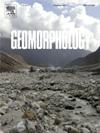Factors controlling the formation and movement of clustered shallow landslides triggered by the extreme rainstorm in July 2023 in Beijing, China
IF 3.1
2区 地球科学
Q2 GEOGRAPHY, PHYSICAL
引用次数: 0
Abstract
Timely recording and analyzing the characteristics of landslides triggered by an extreme climate event is essential for understanding the disaster impacts of such events and for informing disaster prevention efforts. From July 29 to August 2, 2023, a record-breaking rainstorm hit Beijing, and triggered numerous landslides in the western mountainous areas. To enhance the understanding of landslide characteristics and identify their controlling factors, detailed remote sensing interpretation, statistical analysis, and field investigations were conducted. A total of 15,174 landslides have been identified. Small, shallow debris slides are the primary initial failure mode of the landslides, and the subsequent fluidized movement substantially expands the affected area of individual landslides. The landslides are primarily densely distributed in the northwestern and southeastern parts of Mentougou District and the southwestern part of Changping District. Correlation analysis and machine learning regression reveal that landslide distribution density is primarily controlled by precipitation and distance to fault, while landslide mobility is mainly affected by slope gradient. Most of the landslides investigated in the field exhibit translational sliding along the soil-rock interface or rotational sliding in residual gravel soil. The increased fragmentation of rock due to long-term fault activity, which results in reduced weathering resistance, may be the primary reason for the close correlation between landslide distribution and fault location.
求助全文
约1分钟内获得全文
求助全文
来源期刊

Geomorphology
地学-地球科学综合
CiteScore
8.00
自引率
10.30%
发文量
309
审稿时长
3.4 months
期刊介绍:
Our journal''s scope includes geomorphic themes of: tectonics and regional structure; glacial processes and landforms; fluvial sequences, Quaternary environmental change and dating; fluvial processes and landforms; mass movement, slopes and periglacial processes; hillslopes and soil erosion; weathering, karst and soils; aeolian processes and landforms, coastal dunes and arid environments; coastal and marine processes, estuaries and lakes; modelling, theoretical and quantitative geomorphology; DEM, GIS and remote sensing methods and applications; hazards, applied and planetary geomorphology; and volcanics.
 求助内容:
求助内容: 应助结果提醒方式:
应助结果提醒方式:


